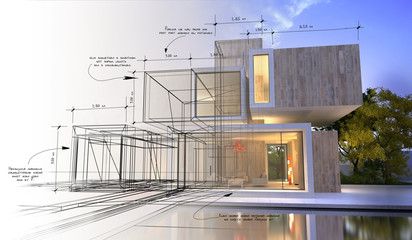Home architecture is more than just building design—it is the art and science of creating spaces that reflect personality, functionality, and lifestyle. The design of a home affects daily living, from how comfortable it feels to how efficiently it uses space and resources. Thoughtful home architecture balances aesthetics with practicality, ensuring that every room serves a purpose while contributing to the overall beauty of the house.

Understanding Home Architecture
Home architecture combines creativity, engineering, and human-centered design to create living spaces that are both beautiful and practical. It involves planning layouts, selecting materials, and designing interiors and exteriors that align with lifestyle needs. The goal is to create a home that is functional, durable, and visually appealing.
Every home tells a story through its architecture. From open-plan living areas that encourage interaction to private retreats for relaxation, the design choices reflect the priorities and tastes of its inhabitants.
Key Elements of Home Architecture
Successful home architecture integrates several essential elements that enhance both form and function:
- Layout and Flow – A well-designed floor plan ensures smooth movement between spaces and optimal use of rooms.
- Lighting – Natural and artificial lighting affect mood, productivity, and the overall ambiance of the home.
- Materials – High-quality, durable, and visually appealing materials contribute to long-term satisfaction.
- Sustainability – Energy-efficient designs and eco-friendly materials reduce environmental impact and utility costs.
- Aesthetic Appeal – The style, color palette, and design features create a home’s visual identity.
Balancing these elements results in a home that is comfortable, functional, and visually striking.
Popular Home Architecture Styles
Home architecture encompasses a wide range of styles, each with unique characteristics. Some of the most popular styles include:
- Modern – Features clean lines, minimalism, and open spaces with large windows for natural light.
- Contemporary – Focuses on simplicity, energy efficiency, and innovative design solutions.
- Traditional – Emphasizes classic features, symmetry, and timeless elegance.
- Colonial – Includes historical elements such as gabled roofs, brick façades, and formal layouts.
- Rustic – Incorporates natural materials like wood and stone, creating a warm, cozy atmosphere.
Choosing a style depends on personal preference, the surrounding environment, and practical needs. Some homeowners combine elements from multiple styles to create a unique, custom look.
The Role of Functional Design
Functionality is at the core of home architecture. A home should not only look good but also meet the practical needs of its occupants. This includes:
- Efficient use of space – Thoughtful layouts maximize usable areas, reduce wasted space, and accommodate changing needs.
- Storage solutions – Built-in cabinets, closets, and hidden storage keep the home organized and clutter-free.
- Adaptable spaces – Rooms that serve multiple purposes, such as a home office that doubles as a guest room, provide flexibility.
- Accessibility – Consideration for mobility and ease of movement ensures comfort for all residents.
Functionality ensures that a home supports daily life, making it more enjoyable and stress-free.
Sustainability in Home Architecture
Sustainable home architecture is becoming increasingly important. Designing with energy efficiency, water conservation, and eco-friendly materials reduces environmental impact and enhances long-term livability.
Some sustainable strategies include:
- Installing energy-efficient windows, insulation, and appliances.
- Utilizing natural ventilation and passive solar design.
- Choosing renewable or recycled materials for construction.
- Incorporating green roofs or gardens to improve air quality and insulation.
Sustainable homes are not only environmentally responsible but also cost-effective, offering lower utility bills and reduced maintenance over time.
Technology and Smart Home Integration
Modern home architecture often integrates technology to improve comfort, security, and efficiency. Smart home systems allow residents to control lighting, temperature, security, and appliances remotely.
Technology can also enhance design by providing advanced modeling tools for architects and homeowners. Virtual tours, 3D renderings, and building simulations help visualize spaces before construction begins, ensuring better planning and fewer mistakes.
Outdoor Spaces and Home Architecture
Home architecture extends beyond interior walls. Outdoor spaces such as patios, decks, and gardens are integral to overall design. They create areas for relaxation, entertainment, and connection with nature.
Key considerations for outdoor spaces include:
- Accessibility and flow from indoor to outdoor areas.
- Landscaping that complements the architectural style of the home.
- Durable and low-maintenance materials for longevity.
- Outdoor lighting and seating arrangements to enhance usability.
Well-designed outdoor areas improve lifestyle quality and add value to the property.
Planning and Collaboration in Home Architecture
Successful home architecture requires collaboration between homeowners, architects, and builders. Clear communication ensures that the design vision aligns with functionality, budget, and timeline.
The process generally involves:
- Consultation and Goal Setting – Discussing lifestyle needs, preferences, and budget.
- Conceptual Design – Developing floor plans, elevations, and design concepts.
- Material Selection and Detailing – Choosing finishes, fixtures, and sustainable solutions.
- Construction and Oversight – Managing the building process to ensure quality and compliance.
- Final Inspection and Customization – Making adjustments and finalizing spaces for occupancy.
Collaboration ensures the final home meets expectations and delivers long-term satisfaction.
The Impact of Home Architecture on Lifestyle
Home architecture shapes daily experiences. A well-designed home enhances comfort, encourages social interaction, supports productivity, and creates a sense of well-being. Natural light, open spaces, and functional layouts contribute to a positive environment, while thoughtful aesthetics make the home enjoyable to inhabit.
A carefully designed home also reflects personal style, providing a sense of pride and emotional connection for its occupants.
Home architecture is a powerful combination of creativity, functionality, and sustainability. It goes beyond building walls—it creates spaces where life unfolds. By integrating thoughtful design, quality materials, and innovative solutions, homeowners can enjoy living environments that are beautiful, practical, and enduring.
Whether building a new home, renovating an existing one, or designing an outdoor space, home architecture shapes the way people experience their surroundings. The right design creates comfort, inspires creativity, and enhances quality of life, proving that architecture is both an art and a vital part of everyday living.